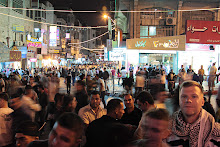To clear a common misconception: this is not the desert. There are deserts to the south (the Judean Desert, the Negev, the Sinai); there are deserts to the east (the Jordan Desert and the Southern Desert); but technically, most of Israel/Palestine--particularly the coastal and highland areas--is a "Mediterranean" climate. This means hot, dry summers and cool winters, with most of the precipitation coming during the winter months. Los Angeles has a Mediterranean climate.
There's plenty of greenery mixed in with the reddish-brown dirt on the hillsides--olive trees and other herbaceous shrubs that are used to long, dry summers. The days can get hot; if you've been looking at the weather applet off to the right, you'll note that the daily high temperature is in the high-80s to mid-90s--but as "they" say, it's a dry heat: the humidity is typically low in the daytime. Ram'allah is in the hill country, about 2900 ft above sea level, less than 40 miles east of the coast. The proximity to a large body of water moderates the regional climate--that is, it stays cooler in the day (and summer) and warmer at night (and winter) around here than it would if the sea weren't so close. Also, every 1000 feet of elevation corresponds to a 2 degree (Farenheit) temperature decrease--so it's cooler up on the hilltop than down in the valley.
So that gives you a sense of the physical geography of the area. What does this mean--and what does it have to do with the night? Most of the nights I've been here, a couple hours after sunset as the temperatures drop and prevailing winds off the Mediterranean push moist air inland, a thick blanket of fog rolls east. As the moist air is forced upward by the hills, it cools and the fog thickens. The hills and valleys are breezy most days and nights, and so standing on the roof of the guest house, several nights now I've watched the fog roll in and over Ram'allah... only to push further east, towards Jericho (of course, Jericho is in the lowlands around the Dead Sea, so it's warmer there, and it's likely the fog dissipates in the warmer air on the other side of the hills). Some thin tendrils of fog linger in the valleys, though, shadowy and cool until the morning sun climbs high enough to burn the shreds away.
If you time it right, then, you can witness this cool, damp blanket being dragged eastward, and watch the lights of Ram'allah change from pinpricks of brightness to fuzzy technicolor orbs.
And last night after the fog rolled through, the crescent moon fell slowly into the sea; from the apartment building just across the street, some Ramadan revelers played Louis Armstrong's What a Wonderful World several times, loud enough for the entire neighborhood to hear and enjoy.
Looking northwest from the roof of the guest house, towards the "suburb" of At-Tireh, with the old Byzantine church, At-Tira mosque and the UNRWA (United Nations Relief Works Agency) compound making the fog glow.



Very neat picture!
ReplyDeleteFunny how Louis Armstrong found his way into the West Bank for Ramadan. :)
Yeah, almost everyone automatically assumes that traveling in the Middle East equates a desert climate. Of course that's what we had in Al Ain but very different from where you are. People also thought that since we were in the desert that there would be camels everywhere even though we lived in a small city. We did see quite a bit of course, but the camels weren't waiting outside for us ;)
ReplyDeleteWe are getting acclimated back home. It was quite a change up going from dry 115 degrees to rainy 70-80s back in Ohio. I forgot how much humidity sucks. I have been quite cold! They say it takes 3 months to acclimate and I have a feeling this is going to feel like an extra cold Fall and Winter for us, or at least, me!